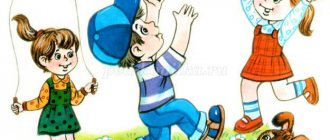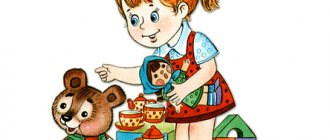Game as a method of environmental education
In didactic games, preschoolers, relying on ideas about natural objects, deepen their knowledge about them. Children independently solve a variety of cognitive tasks: describe objects, identify their characteristic features, guess from descriptions, and combine them according to various properties and characteristics.
The introduction of an element of competition or a problem situation helps to increase the interest of preschoolers in didactic games and natural objects. The introduction of problematic situations into didactic games fills them with environmental content, which, in turn, contributes not only to the enrichment of children’s environmental ideas, but also to the development of a humane attitude towards nature.
Role-playing game by its nature is a reflective activity. The main feature of a role-playing game is the presence of an imaginary situation in it. The imaginary situation consists of a plot and the roles that children take on during the game, and includes the unique use of things and objects.
Mastering knowledge about nature with the help of role-playing games that evoke an emotional response influences the formation of the correct attitude towards objects of the flora and fauna. The need to acquire knowledge about nature and master ways of implementing it in play combines play activities with environmental education. The inclusion of role-playing games in the learning process, in particular in ecology classes, in no way contradicts the formation of independent gaming activities.
The nature of the game is entirely determined by the logic of how the lesson is structured. Therefore, from the very beginning to the end, the course of the game is regulated, it is determined by the teacher: he thinks through, prepares, organizes and directs the game in the right direction. The idea may remain unrealized if the plot does not interest children, does not evoke an emotional response in them, if role behavior is violated, etc.
Research by I.A. Komarova showed that the optimal form of including role-playing games in the process of introducing preschoolers to nature are game-based learning situations (GES), which are created by the teacher to solve specific didactic problems of natural history classes and observations. Three types of IOS have been identified. The main characteristic of the first type of IOS is the use of analogue toys that depict various natural objects. The requirements for the toy are as follows: it must be recognizable - regardless of the material and type of execution, it must display characteristic species-typical features of the structure of an animal or plant. The toy must be aesthetically pleasing - meet modern design requirements and evoke positive emotions in the child.
For example, children in the older group look at a picture in which a mother bear bathes a bear cub in the river, grabbing him by the collar with her teeth. The teacher is faced with a program task: to form in preschoolers realistic ideas about the life of a brown bear in the forest. The teacher brings a soft toy - a cute bear - to class and invites the children to tell the toy bear everything they know about brown bears, about their life in the forest at different times of the year, show him a picture, explain what a forest is, what and why a bear does bear
Children develop a positive emotional state when they see a cute toy and its intentions.
The second type of ITS is associated with the use of dolls depicting characters from literary works that are well known to children in order to arouse interest and attract children’s attention to the didactic goal of the lesson. At the same time, it was discovered that the role of unknown game characters in training is extremely small: they mainly perform an entertainment function, and in some cases even interfere with solving the program tasks of the lesson. The third type of IOS is various versions of the travel game: “Trip to an exhibition”, “Expedition to Africa”, “Excursion to the zoo”, “Journey to the sea”, etc. In all cases, this is a plot-based didactic game included in the lessons, observations, labor. In each specific case, the plot of the game assumes the following: children visit new places, get acquainted with new phenomena and objects as excursionists, tourists, visitors, etc. As part of role-playing behavior, children examine and listen to explanations. The teacher, taking on the role of a tour guide, leader of a tourist group of an experienced traveler, etc., tells and shows the preschoolers everything new for which they set off on their journey.
A large group of games with rules consists of outdoor and outdoor-didactic games. They are based on a variety of movements - walking, running, jumping, climbing, throwing, etc.
Outdoor games satisfy the growing child’s need for movement and contribute to the accumulation of diverse motor experience.
The methodology for conducting outdoor games is similar to the methodology for conducting didactic games and is aimed at gradually developing in children the ability to independently organize these games.
Games of riddle-descriptions are interesting - in them children practice their ability to identify the characteristic features of an object, name them in words, and develop attention. There are a number of collections from which the teacher can choose games with natural content, with the didactic task needed at the time.
Ecological games make it possible to shift the emphasis from preschoolers’ assimilation of ready-made knowledge to an independent search for solutions to the proposed game problems, which contributes to mental education. The use of natural objects and their images in games creates a positive emotional background for the formation of children’s aesthetic feelings. Preschoolers’ correlation of their actions in the natural environment with ethical standards presented in game tasks contributes to moral education. Awareness of oneself as a part of nature, a value-based attitude towards oneself, as well as towards other living organisms, promotes physical development.
By mastering colors, their shades, the shape of objects, manipulating toys and other play equipment, and acquiring certain sensory experiences, children begin to understand the beauty of the world around them.
Few studies examine the educational significance of didactic games: their role is shown in the comprehensive development of the individual, in the formation of a child’s abilities, the development of social activity, the development of the will and volition of a preschooler, the assimilation of rules of behavior, the creation of conditions for the emergence of a conscious assessment of one’s capabilities and skills, and the provision of an emotional character. activities, the possibility of their use for the purpose of behavior correction has been identified.
A.V. Zaporozhets, assessing the role of the didactic game, rightly pointed out: “We need to ensure that the didactic game is not only a form of assimilation of individual knowledge and skills, but also contributes to the overall development of the child and serves the formation of his abilities.” A.N. Leontyev, analyzing the significance of didactic games for the development of the basic personality traits of a child, points out two points that determine the role of this type of play activity. The first is that games create conditions in which “the child’s independent conscious assessment of his specific capabilities of skills” appears for the first time. The second relates to the moral aspects contained in games with a dual task (didactic and educational). “And here... the important thing is that this moral moment appears in the activity of the child himself, that is, actively and practically for him, and not in the form of an abstract moral maxim that he listens to.”
I.A. Komarova developed and tested a variety of game-based learning situations in the classroom and in the process of systematic observations. A unique play element used by the researcher was a toy (mainly a doll depicting fairy-tale characters, children's cartoon characters and television shows), around which the activity unfolded. In the course of experimental work, game characters were associated with various elements of the role-playing game and with the didactic content of the lesson, resulting in the formation of game-based learning situations (GTS).
CONCLUSION
Play is not only entertainment, but also a method by which young children get to know the world around them. The younger the children, the more often the game is used as a method of educational work with them. Summarizing all of the above, we can formulate the following main conclusions: games of ecological content help the child to see the uniqueness and integrity of not only a certain living organism, but also the ecosystem. Realize the impossibility of violating its integrity and uniqueness. Understand that unreasonable intervention in nature can lead to significant changes both within the ecosystem itself and outside its boundaries in their properties and qualities, characteristics and manifestations, to participate in creating the necessary conditions for the normal functioning of living beings within the reach of children, to understand the importance of nature conservation, consciously complying with the norms of behavior in nature.
Based on this, it can be assumed that didactic games of environmental content ensure not only the effectiveness of preschoolers’ assimilation of ideas about the rules of behavior in nature, but also their observance in real interaction with nature. Monitoring their observance by an adult and peers helps prevent negative actions of children in the natural environment and educate preschoolers to have a conscious attitude towards living things.
Didactic games use natural objects of nature (vegetables, fruits, flowers, stones, seeds, dry fruits), pictures of plants and animals, board games and all kinds of toys. Didactic games with natural material or images of it are the main way of sensory education and the development of cognitive activity. Games are carried out during classes, excursions, walks at specially designated times.
Bibliography:
- Nikolaeva S.N. – “Methodology of environmental education of preschool children”, Moscow, 2001.
- Nikolaeva S.N. – “Environmental education of younger preschoolers”, Moscow, 2000.
- Vygotsky L.S. - “Collected Works” volume 5, Moscow, 1983.
- Dryazgunova V.A - “Didactic games for introducing preschoolers to plants.” Moscow, 1981
- Nikolaeva S.N. – “Young Ecologist”, Moscow, 1999.
- Nikolaeva S.N., Komarova S.A. – “Story games in environmental education of preschool children”, Moscow, 2003.
- Ryzhova N.A. – “Environmental education in kindergarten”, Moscow, 2001.






